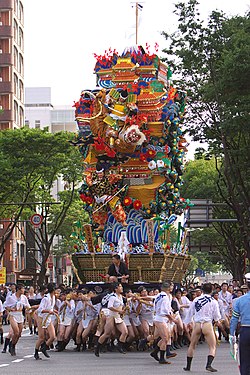| Hakata Gion Yamakasa | |
|---|---|
 | |
| Observed by | Hakata, Fukuoka |
| Type | Religious |
| Begins | 1 July |
| Ends | 15 July |
| Date | Month of July |
| Related to | Fukagawa Matsuri, Sannō Matsuri |
Hakata Gion Yamakasa (博多祇園山笠) is a Japanese festival celebrated from the 1st until the 15th of July in Hakata, Fukuoka. The festivities are centered on the Kushida Jinja. The festival is famous for the Kakiyama, that weigh around one ton and are carried around the city as an act of float-racing. The festival is believed to be over 770 years old and attracts up to a million spectators each year. It was designated an Important Intangible Folk Cultural Property of Japan in 1979. [1] [2] [3] The origin of the festival is believed to date back to 1241, when the founder of Joten-ji temple, monk Enni had people carry him around the town on a float, while praying in order to get rid of the plague which is considered to have been successful. [4] The sound of the Yamakasa has also been selected by the Ministry of the Environment as one of the 100 Soundscapes of Japan. [5] [6]
Floats
The floats, called Yamakasa, are divided into two groups. The Kakiyama are the smaller, carryable floats, that are raced through the town, while the Kazariyama are stationary floats, that are built up to 13 metres high and often depict historic or mythical events of Japanese culture. Originally the Kakiyama and Kazariyama were one and the same, with the large floats being carried through the city. However the Yamakasa were split up in 1898 when the electrical power lines in Hakata became too common for large Yamakasa to be carried through the streets.
Hakata districts
Hakata, once its own city, merged with Fukuoka in 1876. The festivities are mostly based in Hakata.
Hakata was divided into seven districts by Toyotomi Hideyoshi in 1586/1587. Some of these districts have changed names and exact boundaries multiple times; they still see themselves as the original seven districts. Soon after the division, carrying the Yamakasa through one's own district became a competition for speed. Today, the main event, the Oiyama, is a race between the districts.
The districts are Higashi-nagare, Nakasu-nagare, Nishi-nagare, Chiyo-nagare, Ebisu-nagare, Doi-nagare and Daikoku-nagare.
See also
- Matsuri
- Gion Matsuri
- List of Important Intangible Folk Cultural Properties
- Important Intangible Cultural Properties of Japan
- 100 Soundscapes of Japan
References
- ^ "Hakata Gion Yamakasa Festival". Japan National Tourism Organization. Archived from the original on 18 February 2011. Retrieved 20 March 2011.
- ^ "Hakata Gion Yamakasa". Fukuoka City. Retrieved 20 March 2011.
- ^ "Database of Registered National Cultural Properties". Agency for Cultural Affairs. Archived from the original on 23 December 2019. Retrieved 20 March 2011.
- ^ "Spots/Hakata Area/ History and Culture/Jotenji temple". Fukuoka Official Tourist Guide. Retrieved 20 March 2024.
- ^ "100 Soundscapes of Japan". Ministry of the Environment. Archived from the original on 8 June 2012. Retrieved 18 April 2011.
- ^ "6G - Conservation of Good Sound Environment". Ministry of the Environment. Archived from the original on 29 July 2012. Retrieved 21 April 2011.
External links
- (in Japanese) Hakata Gion Yamakasa homepage
- (in English) Hakata-Gion-Yamakasa Portal Site: Yamakasa-Navi
- Hakata Gion Yamakasa NHK